And other lightsaber physics
Welp. Star Wars Episode IX came and went, bringing with it a stark and definitive closure to the paths of our newest heroes and heroines in the beloved saga. Though the acting, cinematography, and special effects are largely praised as some of the greatest to yet graze the franchise, the plot of the third installment of the sequel trilogy has no doubt ignited heavy debates among fans of all ages, perhaps polarizing the Star Wars fandom more than any film before it. It?s hard to peruse through even a handful of movie reviews on Medium without encountering someone?s unique take on the multi billion dollar series that has ushered in an entirely new generation of fans. Despite the massive array of differing opinions on the eleven renowned films, there is one thing that all fans of Star Wars can agree on: lightsabers are really, really cool.
Or should I have said ?hot?? Extremely hot, to be precise! Hot enough, in fact, to slice right through Darth Maul in a fraction of a second, and cauterize the bisection completely. Hot enough to carve through solid metal blast doors, stronger than steel and thicker than trees. Hot enough to chop stone pillars, metal coolant pipes, and enormous boulders with as much ease as sliding a hot knife through warm butter. Pretty much anything that a lightsaber touches is immediately converted to a molten liquid or a charred crisp, and when one lightsaber clashes with another, a flash ensues that is so bright that it momentarily saturates one?s entire field of vision. So yes, in addendum, lightsabers are really, really hot!
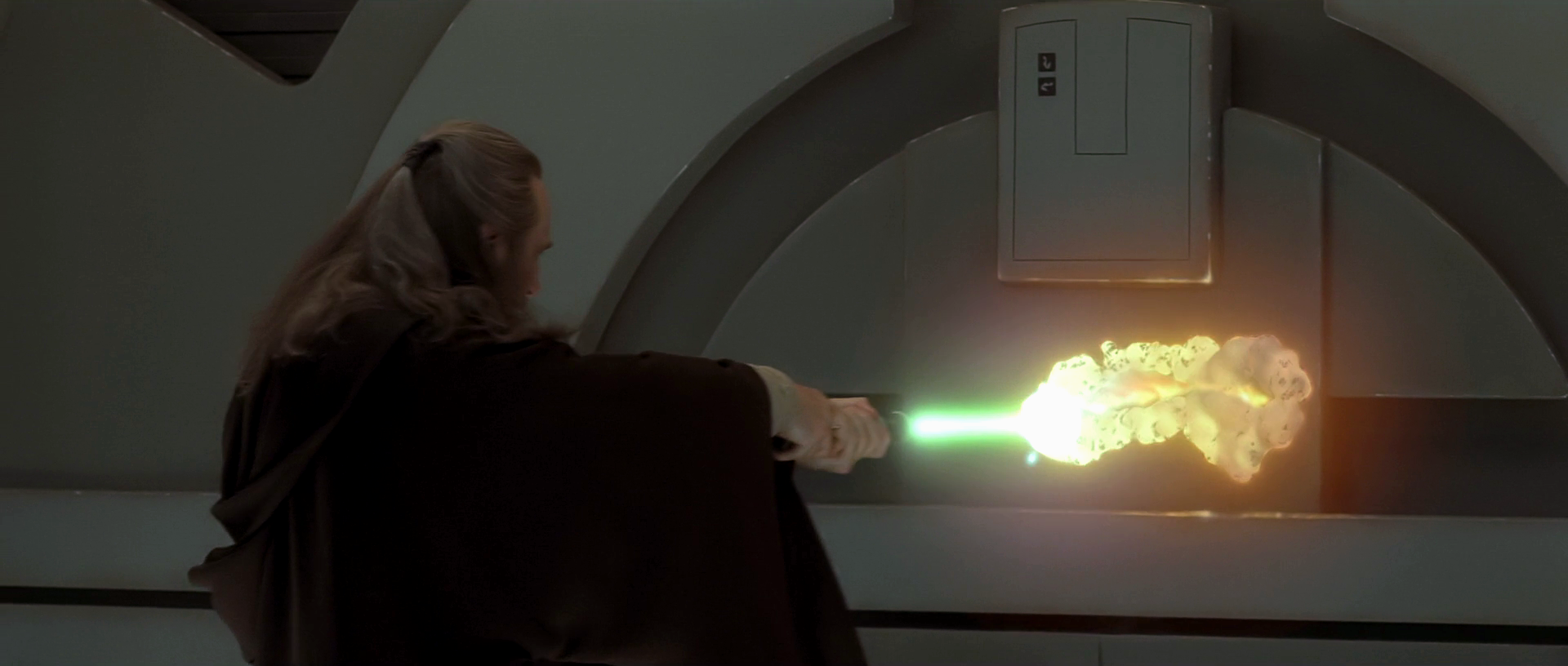 Qui Gon slicing through a blast door in Star Wars Episode I: The Phantom Menace.
Qui Gon slicing through a blast door in Star Wars Episode I: The Phantom Menace.
Star Wars may have taken place in a galaxy far, far away, but we are still led to presume this galaxy does indeed exist somewhere in our universe. This means that all of the technology depicted in the many films should still abide by our known laws of science and physics. So, keeping all that in mind, how hot would the lightsabers depicted in the films actually need to be to do what they do? To answer this question, let?s first take a look at how the Star Wars canon describes the functionality of a lightsaber. From Wookiepedia:
Lightsabers consisted of a plasma blade, powered by a kyber crystal, that was emitted from a usually metal hilt that could be shut off at will.
There is some other pseudo-scientific discussion about power cells, modulation circuits, and energy gates, but this basic description tells us two important things: 1) That a lightsaber blade is made of plasma i.e. superheated atomic material, and 2) That they have a single power source ? a ?kyber crystal? ? which presumably fits snugly within the lightsaber?s hilt. Unless the kyber crystal is somehow harnessing power from an external source (such as Casimir or Zero-Point energy), a kyber crystal can be thought of as an extremely advanced and powerful battery, with enough juice to power the lightsaber whenever active.
In order to gauge a rough order-of-magnitude estimate for the temperature of a lightsaber, we need an example of one slicing through something pretty thick that we also know the material properties of. This isn?t as easy as it sounds ? probably 99% of all saber slices in the franchise are that of crates, pipes, or doors with ambiguous compositions, or people?s limbs, neither of which make a very good test of determining a lightsaber?s power output. However, there is one fantastic scene in Star Wars Ep. VIII where Rey slices through a stone while training with Luke Skywalker on Ahch-To, providing us a pristine example of the true power of a Star Wars lightsaber.
 Rey slices through a stone while training on Ahch-To; one of the few instances where a lightsaber is used in the franchise to cut something that?s physical properties are known!
Rey slices through a stone while training on Ahch-To; one of the few instances where a lightsaber is used in the franchise to cut something that?s physical properties are known!
In the scene, Rey is testing her skills with the Jedi weapon, swinging it within centimeters of the tall, weathered stone, only to pull it back to reset the exercise. She repeats the drill several times before finally losing her restraint and driving the lightsaber clean through the solid stone, sending the top half careening down the mountainside. Beautiful and symbolic as the scene was, it?s also a gold mine for calculating a lightsaber?s power. Not only is the stone made of a material with predictable physical traits, but we also gain some valuable insight on the size of the cross section that is sliced, as well as the amount of time that it took to completely liquify the rock within the cross section. These tidbits will turn out to be valuable assets in determining the lightsaber?s power output, and thus its temperature.
Most silicate stones have melting points between 700? C, and 1300? C. For the sake of simplicity, let?s assume that Rey?s lightsaber must heat up and liquify the material along the cross section to a temperature of 1000? C (the same as the melting point of basalt). The energy required to melt a substance, however, is more than just increasing its temperature to its melting point; additional energy (called latent heat of fusion) is required to actually turn that 1000? C solid material into 1000? liquid material. For example, picture an ice cube sitting on your counter. The temperature of solid ice can never exceed 0? C, yet it still takes several minutes of sitting on your counter absorbing heat in your ~21? C kitchen in order to melt it into its liquid state. This means that we will need two additional factors to calculate our lightsaber temperature ? the specific heat of stone (as the solid stone heats up to 1000? C), and the latent heat of fusion of stone (as the stone changes to a liquid state).
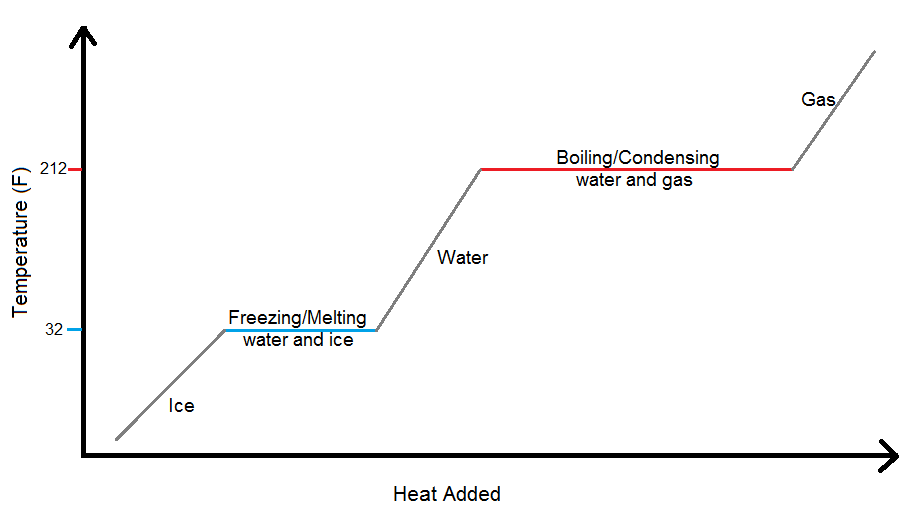 A phase change diagram for water. Note that the temperature of the water does not change during the melting/freezing phase, nor during the boiling/condensing phase, due to the added energy going towards changing the state of the water instead of increasing its temperature.
A phase change diagram for water. Note that the temperature of the water does not change during the melting/freezing phase, nor during the boiling/condensing phase, due to the added energy going towards changing the state of the water instead of increasing its temperature.
Clearly, heating 1 gram of rock from room temperature to a molten liquid requires less energy than doing the same for 1 kilogram of rock. In order to estimate a lightsaber?s heat output, we will need to determine the volume (and thus the mass) of rock which is being liquified. We can probably roughly estimate the cross section of Rey?s slice from the scene in the movie, but this does not determine the volume of material that is liquified. To obtain this, we must be able to estimate the height of Rey?s cut. Logic would tell us that the height of the cross section is probably about the same as the thickness of the lightsaber itself, so what is the thickness of a lightsaber blade? Lightsabers have been depicted in many thicknesses throughout the franchise. In the originals, they were extremely thin, sometimes completely disappearing when viewed edge-on. By the time of the prequels and beyond, lightsabers took on a thicker, more sword-like appearance. Because our example takes root in the sequel trilogy, I will use an estimated thickness of perhaps 3 centimeters.
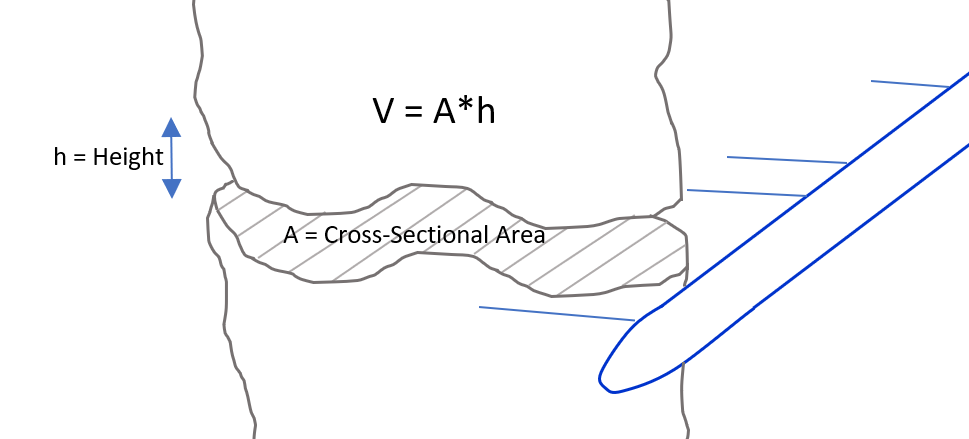 A diagram I made in MS Word (lol) showing the volume of material liquified by the lightsaber as a function of cross-sectional area and height of the slice, the latter of which is roughly the same as the thickness of a lightsaber?s blade itself.
A diagram I made in MS Word (lol) showing the volume of material liquified by the lightsaber as a function of cross-sectional area and height of the slice, the latter of which is roughly the same as the thickness of a lightsaber?s blade itself.
We now have enough information to determine how much energy it takes to liquify the cross sectional slice from Rey?s lightsaber, but we still need one more factor to determine how much power Rey?s lightsaber is radiating. If the lightsaber itself were 1000? C, it could theoretically liquify the entire cross section, but it would take it an infinite amount of time to do so. The hotter the blade is, the faster it will be able to slice through the rock. By carefully timing the scene from the beginning of slice to the end, we can determine the amount of time Rey spends bisecting the stone, which will then allow us to reverse-calculate the amount of thermal power radiating from the lightsaber?s blade. By assuming that this power is uniformly radiated from the surface area of the lightsaber, we can finally tabulate the temperature of the weapon. For those interested in all the math:
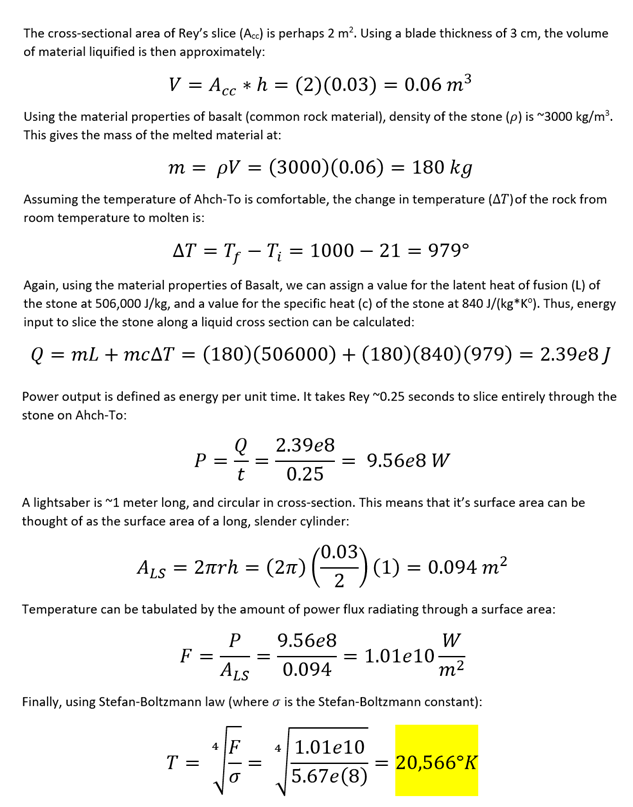 Hahahahaha damn.
Hahahahaha damn.
Boasting a power output greater than some nuclear powerplants, the nearly 1-Giggawatt lightsaber would flare at a temperature hotter than the surfaces of most of the stars in our universe. To keep the lightsaber ignited for a mere 20 minute duel, the kyber crystal within the lightsaber?s hilt would have to yield an energy density of about 1,670 Gigaojoules per liter ? akin to the volume energy density of a plutonium fission reactor! Peaking at emission wavelengths in the UV spectrum, an object of this temperature would likely appear bright purple to the naked eye, not dissimilar to the lightsaber of Mace Windu.
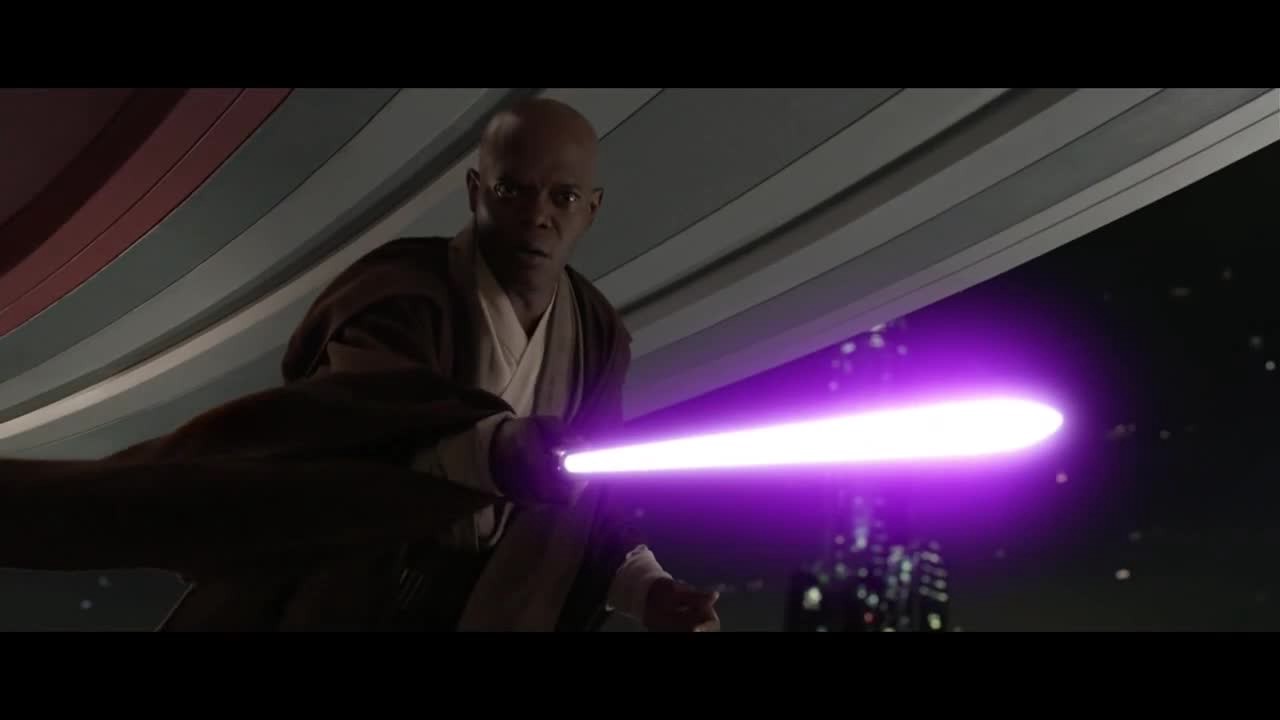 Is Mace Windu?s lightsaber the most visually accurate lightsaber?
Is Mace Windu?s lightsaber the most visually accurate lightsaber?
However, anyone holding such a lightsaber would actually burst into flames. This is because the autoignition temperature of biological material would be in the range of combustion even out to a distance of more than a football field away just from the radiative heat of the lightsaber?s blade! Now clearly Jedi and Sith aren?t bursting into flames while dueling, so something else must be at play here. My theory: the pseudo-scientific ?energy gates? touched on in Wookiepedia are actually extremely advanced fields of some sort, designed to contain the superheated plasma and *most* (I?ll come back to this) of the radiation from escaping the blade while not in contact with anything solid. The energy from a lightsaber is only released when that field is interrupted by a solid object or another blade, and only the surface area of the lightsaber that is actually slicing or colliding is releasing energy. The rest of the saber?s energy gate field remains intact to protect the user from succumbing to 3rd degree burns. This theory would also explain why a lightsaber collision generates a momentary blinding flash, since a split second of Gigawatt-level power is released during each clash.
Since this hypothetical field would block *most* of the radiation from getting through, the energy storage demands of the kyber crystal are actually much less stringent than what I previously estimated. It would still require Gigawatt levels of peak power in order to slice rock and metal, but since this power is only required during short bursts, energy from the kyber crystal would only be draining sporadically, instead of continuously. With the same energy density listed previously, a lightsaber could last weeks or even months of duals before a change of kyber crystal would be required ? much more believable to be done offscreen than every 20 minutes. Finally (I said I would come back to it), a Jedi or Sith could perhaps adjust the energy gate to tweak the amount and frequency of allowed radiation that gets through the field in order to customize the color of their lightsaber blade, allowing for any saber color under the sun(s).
So yeah, in conclusion, I guess lightsabers are pretty cool? erm, well? hot! Thanks for reading!
 Lol who gave Vader a pink lightsaber?
Lol who gave Vader a pink lightsaber?
Special thanks to Ryan Moen for allowing me to share his movie review of the sequel trilogy in my article. If you enjoy movie reviews of any variety, give him a follow!


